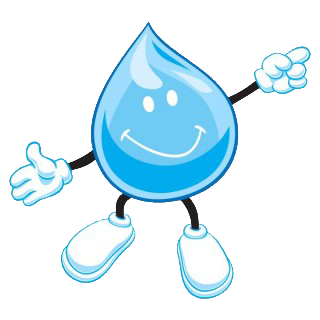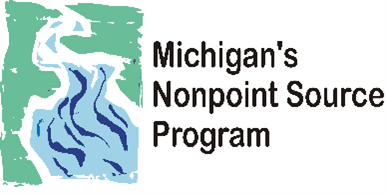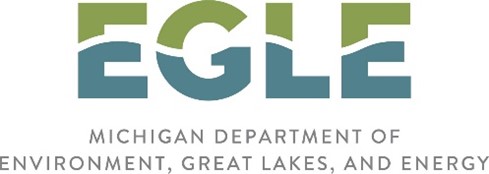The Kalamazoo Water Pumping Stations add small amounts of chlorine for disinfection, fluoride to keep your teeth healthy and a phosphate to help control iron and provide corrosion control in the water pipes.
-Henry the Water Drop

Henry Says
City of Kalamazoo - Protect Your Water provides the following water vocabulary to familiarize you with key terminology.
AQUIFIER
A body of rock or sediment that holds groundwater.
BERM
A constructed barrier of compacted earth.
BEST MANAGEMENT PRACTICE (BMP)
Describes ways to manage your land and activities to mitigate pollution of surface and groundwater near you.
CAPTURE ZONE
The surface and subsurface area surrounding a water well or wellfield which supplies a public water system, through which contaminants are reasonably likely to move toward and reach such water well or wellfield within a specified period of time.
CATCH BASIN
A receptacle, located where a street gutter opens into a stormwater sewer, designed to retain matter that would not readily pass through the sewer.
CONTAMINANT
Any physical, chemical, biological or radiological substance or matter that degrades water quality and/or threatens the safety of its intended use such as drinking water. Some contaminants are only an aesthetic concern, while others are considered hazardous to your health.
CULVERT
Pipe or concrete box structure which drains to open channels, swales, or ditches under a roadway or embankment typically with no catch basins or manholes along its length.
EUTROPHICATION
A common process brought about by over fertilizing with excess phosphorus and nitrogen entering an aquatic system, creating overgrowth of aquatic plants, that then die off and get broken down by microorganisms that deplete the oxygen levels in the water.
EVAPOTRANSPIRATION
The combined loss of water from an area through transpiration of plants and evaporation from soil or water.
GLACIAL DRIFT
A general term for unconsolidated sediment transported by glaciers and deposited directly on land or in the sea.
GREEN INFRASTRUCTURE
An approach to water management that stores, protects, and mimics natural systems and their ability to control and regulate water movement.
ILLICIT DISCHARGE
Any discharge into a storm drain that is not composed entirely of stormwater.
IMPERVIOUS SURFACE
A hard surface area which either prevents or retards the entry of water into the soil mantle as under natural conditions prior to development; and/or a hard surface area which causes water to run off the surface in greater quantities or at an increased rate of flow from the flow present under natural conditions prior to development.
INFILTRATION OR PERCOLATION
The process by which water on the ground surface enters the soil.
NATIONAL POLLUTANT DISCHARGE ELIMINATION SYSTEM (NPDES)
The part of the Clean Water Act which requires point source and non-point source dischargers to obtain permits for stormwater collection systems. In Michigan, these permits, referred to as NPDES permits, are administered by the Michigan Department of Environment, Great Lakes, and Energy (EGLE).
PERMEABILITY
The capacity of rock or soil to transmit water.
POINT SOURCE OF POLLUTION
Contaminants found in water that can be readily identified from a specific source such as a leaking underground storage tank or a factory sewage pipe.
POLLUTANTS
Stormwater pollution can include chemicals, fast food wrappers, cigarette butts, Styrofoam cups, sewage overflow, cooking oil, bacteria from pet waste, used motor oil, fertilizers, paint and construction debris.
PPB - PARTS PER BILLION
PPM - PARTS PER MILLION
PRECIPITATION
Rain, snow, sleet, or hail that falls to the ground as a part of the water cycle.
RAIN GARDEN
A specifically designed landscape planted with native flowers to help absorb, slow down, and retain stormwater runoff.
RIPARIAN ZONE
Land that runs adjacent or alongside a waterbody.
SANITARY SEWER OVERFLOW (SSO)
A condition in which untreated sewage is discharged from a sanitary sewer into the environment prior to reaching sewage treatment facilities. When caused by rainfall it is also known as wet weather overflow. Examples are blockage or broken of sewer lines, infiltration/inflow of excessive stormwater into sewer lines during heavy rainfall, malfunction of pumping station lifts or electrical power failure.
STORMWATER
Water that originates from precipitation and is a type of surface water created during abnormally large rain or snow falls.
STORMWATER RUNOFF
It is stormwater running off, draining away and flowing over ground surfaces. It is created when rain falls or snowmelt run off roads, driveways, parking lots, rooftops and other paved or impervious surfaces that do not allow water to soak into the ground.
SURFACE WATER
Water that collects on the ground surface from precipitation (oceans, streams, lakes, ponds, and other bodies of water found on the Earth's surface).
TOTAL MAXIMUM DAILY LOAD (TMDL)
The maximum amount of pollutants that a system can receive and still meet water quality standards.
PPM (parts per minute)
A ratio used to describe the proportion of one substance to another. In terms of time, 1 ppm is equal to 1 minute in 2 years.
WATERSHED
An area of land that drains to a single surface water outlet and is separated from other watersheds by a divide.
WATER TABLE
The top of an unconfined aquifer where water pressure is equal to atmospheric pressure; in other words, the surface between the zone of saturation and the zone of aeration. The water table depth fluctuates with climate conditions on the land surface above and is usually gently curved and follows a subdued version of the land surface topography.
WELLHEAD PROTECTION
A surface and subsurface land area regulated to prevent contamination of a well or well-field supplying a public water system.
WETLAND
An area inundated or saturated by ground or surface water at a frequency and duration sufficient to support, and that under normal circumstances do support, a prevalence of vegetation typically adapted for life in saturated soil conditions. Wetlands generally include swamps, marshes, bogs, and similar areas.
This project has been funded wholly or in part by a grant through the Watershed Council Support Program by the Michigan Department of Environment, Great Lakes, and Energy's Nonpoint Source Program to Kalamazoo Stormwater Working Group for the Multilingual Outreach and Education project. The contents of the document do not necessarily reflect the views and policies of the Department of Environment, Great Lakes, and Energy, nor does the mention of trade names or commercial products constitute endorsement or recommendation for use.
Este proyecto ha sido financiado en su totalidad o en parte por una subvención a través del Programa de Apoyo del Consejo de Cuencas Hidrográficas del Departamento de Medio Ambiente, Grandes Lagos y Energía de Michigan, Programa de Fuentes No Puntuales para el Grupo de Trabajo de Aguas Pluviales de Kalamazoo para el proyecto de Educación y Alcance Multilingüe. El contenido del documento no refleja necesariamente los puntos de vista y las políticas del Departamento de Medio Ambiente, Grandes Lagos y Energía, ni la mención de nombres comerciales o productos comerciales constituye respaldo o recomendación para su uso.
Stormwater 101
Stormwater is water from precipitation that flows across the ground and pavement when it rains or when snow and ice melt. Stormwater eventually infiltrates through the ground (contributing to groundwater), runs directly into natural surface water features, evaporates or drains into systems of underground pipes or roadside ditches and may travel for many miles before being released into a lake, river, stream or wetland area.


